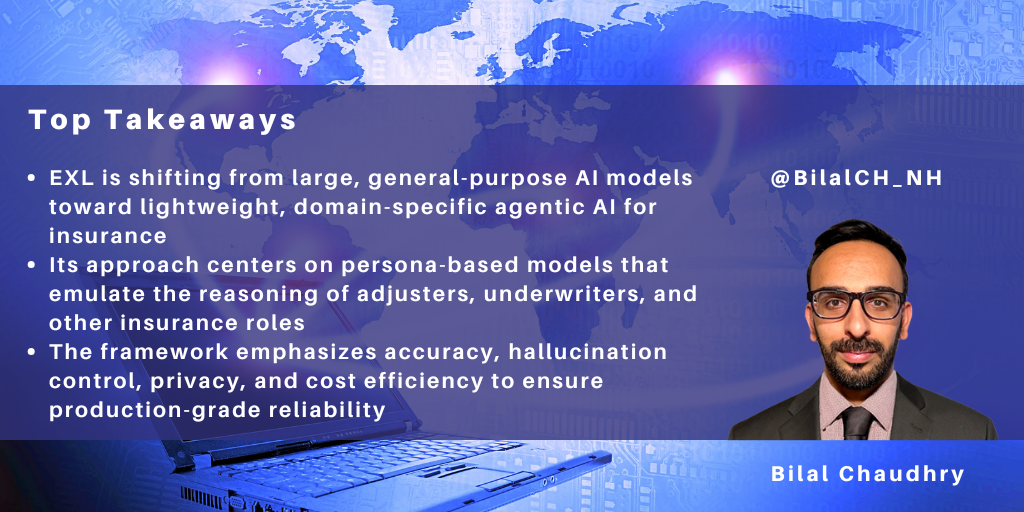Search posts by keywords:
Filter posts by author:
Related Reports
Related NEAT Reports
Other blog posts
posted on Oct 09, 2025 by Bilal Chaudhry

EXL recently briefed me on how it is leveraging agentic AI in the insurance industry, a sector that is at a turning point in its AI journey. Early experiments with large, general-purpose models have proven what’s possible, but they’ve also revealed what does not work. Hallucinations, high costs, and generic outputs are incompatible with an industry built on precision, regulation, and trust. The next phase of AI in insurance is not about size, but about fit, embedding intelligence directly into workflows, tuned to exact personas that power the insurance value chain.
EXL is combining access to proprietary data with fine-tuned, lightweight models, moving beyond demonstrations of AI potential into real-world deployment. Its approach is rooted in a simple but core concept: building AI agents that think, behave, and make decisions like insurance professionals.
Why General Models Are Not Enough
The promise of massive LLMs like GPT-5 or Gemini is undeniable. They are powerful tools for research, writing, and general reasoning. But in insurance, the stakes are different. Claims adjudication, underwriting, and fraud detection demand more than a generalized understanding of language. They require context, accuracy, privacy, and compliance, all while operating within cost constraints.
A generic model might summarize a news article. But it cannot reliably triangulate 800 pages of medical records, calculate fair claim valuations, or spot subtle fraud indicators buried in policy notes. Bridging the gap between general potential and domain precision is where EXL is building an advantage.
Persona-Based Domain Models
Rather than chasing the biggest model, EXL is building smaller, purpose-built models that mimic specific roles inside an insurance organization. Claims specialists, underwriters, and subrogation adjusters each have their own reasoning process, data dependencies, and decision criteria. By training lightweight models on proprietary derivatives datasets, EXL has created a portfolio of “co-workers” designed to fit seamlessly into insurance operations.
This persona-based approach is reinforced by a deliberate balance across five design factors: accuracy, hallucination control, cost efficiency, data privacy, and latency. The result is AI that not only works, but works in production environments when regulators, clients, and customers demand reliability.
Use Cases Across the Value Chain
Claims Adjudication/Medical Claims Review
- AI agents summarize months of claim history into clean, chronological narratives
- Adjusters can query claims directly with natural language questions, retrieving answers instantly
- Document intelligence agents process incoming files and communications, updating propensity models for fraud, recovery, or liability. In some cases, they even draft recovery letters automatically
- In workers’ compensation, disability, and liability lines, medical files average 500-800 pages
- EXL’s models tag ~40 key sections, generate structured summaries, and deliver consistent interpretations that reduce reliance on overburdened medical staff, eliminating human error.
Life Underwriting
- Finely-tuned models triangulate across medical, financial, and lifestyle data to recommend underwriting decisions
- Instead of a weekly manual review, underwriters gain structured insights in minutes.
Property Underwriting (Multimodal)
- Moving beyond text, EXL integrates images from mobile apps, drones, and satellite surveys
- AI agents review property images to surface underwriting concerns, allowing underwriters to make faster, more informed decisions.
Intellectual Property and Market Adoption
This work is not just conceptual; EXL has secured a U.S. patent for its insurance LLM, with additional patents underway for Claims Assist and other solutions. Early adopters in APAC, the U.K., and the U.S. are already deploying modules, whether for claim summarization, fraud propensity scoring, or recovery optimization
The modular design is intentional. Insurers no longer have to rip and replace existing systems. Instead, they can embed targeted AI agents where pain is the greatest, cutting review times, improving decision quality, and reducing costs step by step.
Why it Matters
For insurers, the benefits are clear:
- Efficiency: reducing adjuster review times from 20-25 minutes to seconds
- Consistency: minimizing variation inherent in human-only decision making
- Cost savings: leveraging lightweight models that are cheaper to run than mega-LLMs
- Scalability: applying persona-based designs across lines of business and geographies.
But the bigger story is cultural. Insurers are moving away from AI as an “experiment on the side” and into a future where intelligence is embedded directly into the workflows that define their business.
The Right Model, Not the Biggest Model
The race to build trillion-parameter models makes headlines, but the more pressing question is who has the right model. EXL frames its agentic AI approach as a way of thinking differently about adoption, one that is persona-based, lightweight, and modular, rather than generic or monolithic. By training models to act like adjusters, underwriters, or surveyors, EXL is positioning itself to help insurers address pain points where efficiency and consistency matter.
From an industry perspective, this is notable. Insurers continue to test and experiment with large, general-purpose models, yielding mixed results, as they encounter challenges with accuracy, privacy, and cost. Agentic AI offers a bridge between experimentation and operational adoption. EXL’s proprietary data rights and patent-backed IP are designed to provide a durable foundation for building agentic AI capabilities tailored to the needs of insurance clients.
The approach and opportunity presented here are promising, though hurdles are to be expected along the way. Adoption has already begun in claim summarization, recovery scoring, and underwriting support, and is expected to extend further into decision-heavy functions where explainability and regulatory oversight will be critical. If agentic AI develops as EXL anticipates, it will not only improve near-term efficiency but possibly reshape how insurers structure work and allocate expertise across the value chain in the years ahead.
